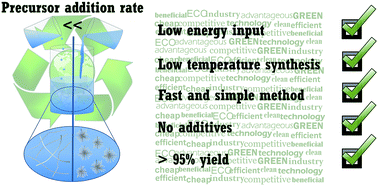Green synthesis of biomimetic CePO4:Tb nanostructures using the simplest morphology control†
Abstract
A simple, environmentally and economically benign, scalable synthesis was developed for the production of micrometer long hexagonal cerium phosphate nanowires, complex urchin-like nanostructures and their terbium-doped counterparts. It was proven that neither sophisticated equipment nor structure directing agents or pH adjustment or tedious procedures are necessary, because the precise regulation of precursor addition rate is sufficient to control the morphology of the product nanostructures. Nanowires and nanourchins can be obtained by the instantaneous vs. drop-wise addition of phosphoric acid to an aqueous cerium nitrate solution, respectively. Terbium doping is readily achieved by dissolving a calculated amount of terbium nitrate in the precursor solution. Spherulitic lanthanide phosphate nanostructure formation mechanisms offered in the literature were critically reviewed and assessed against our experimental findings obtained by studying the sonochemical disintegration of nanourchins. Terbium doping introduced green luminescence and slowed down the temperature induced hexagonal to monoclinic phase transition of cerium phosphate.


 Please wait while we load your content...
Please wait while we load your content...